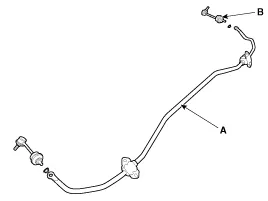Hyundai Genesis (DH): Rear Suspension System / Rear Stabilizer Bar Repair procedures
Hyundai Genesis (DH) 2013-2016 Service Manual / Suspension System / Rear Suspension System / Rear Stabilizer Bar Repair procedures
| Removal |
| 1. |
Loosen the wheel nuts slightly. Raise the vehicle, and make sure it is securely supported. |
| 2. |
Remove the front wheel and tire (A) from the rear hub.
|
| 3. |
Loosen the bolts and remove the cover (A). [TAU]
|
| 4. |
Using a hex wrench, loosen the nut (A) while fixing the end of stabilizer link and then disconnect the link from the lower arm.
|
| 5. |
Loosen the mounting bolt (A) and then remove the stabilizer bar (B).
|
| 6. |
Disconnect the rear stabilizer link (B) with the stabilizer bar (A).
|
| 7. |
Installation in the reverse order of removal. |
| Inspection |
| 1. |
Check the bushing for wear and deterioration. |
| 2. |
Check all the bolts. |
| 3. |
Check the stabilizer bar for deformation. |
Removal 1. Loosen the wheel nuts slightly. Raise the vehicle, and make sure it is securely supported. 2. Remove the front wheel and tire (A) from the rear hub.
Other information:
Hyundai Genesis (DH) 2013-2016 Service Manual: Blind Spot Detection Switch Repair procedures
Removal 1. Disconnect the negative (-) battery terminal. 2. Remove the crash pad lower panel. (Refer to Body - "Crash Pad") 3. Remove the blind spot detection (BSD) switch (A) after disengaging the mounting clip. Installation 1. Install the crash pad side switch assembly after connecting the connector.
Hyundai Genesis (DH) 2013-2016 Service Manual: Blind Spot Detection Indicator Components and Components Location
C
Categories
- Manuals Home
- Hyundai Genesis Owners Manual
- Hyundai Genesis Service Manual
- Lift And Support Points
- Automatic Transmission Control System
- Thermostat Repair procedures
- New on site
- Most important about car
Copyright © 2025 www.hgenesisdh.com - 0.0284






